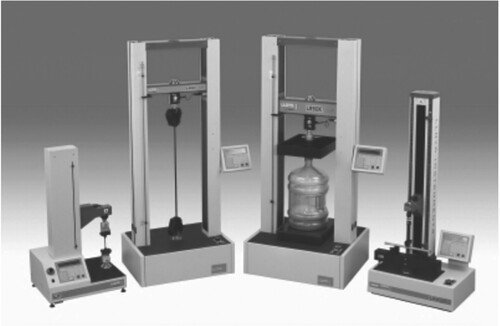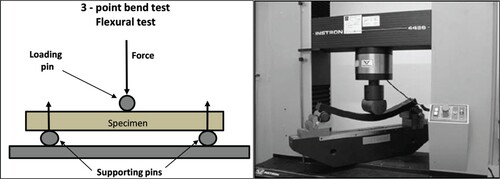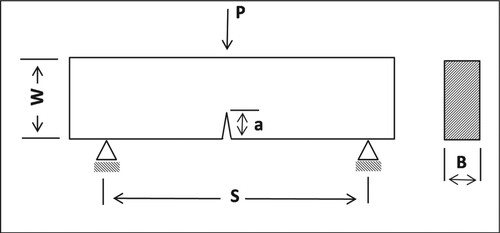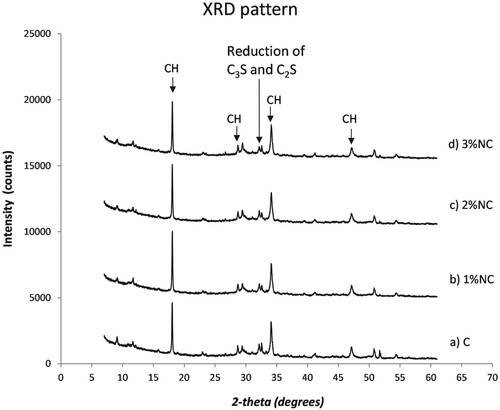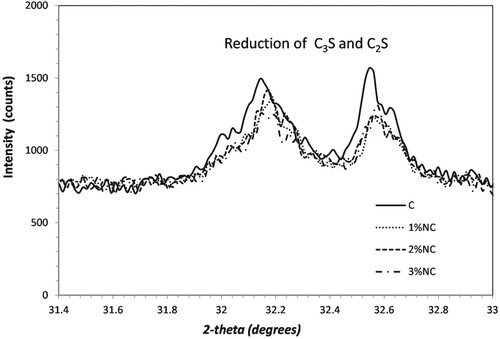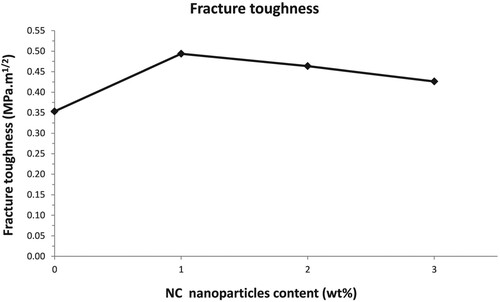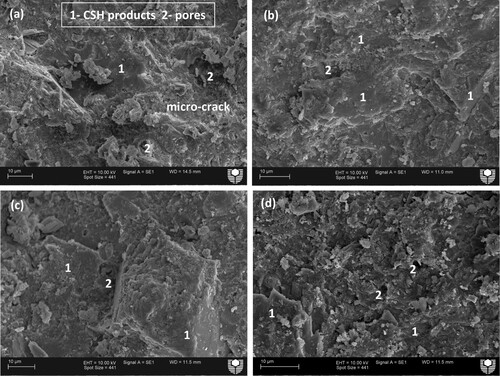 ?Mathematical formulae have been encoded as MathML and are displayed in this HTML version using MathJax in order to improve their display. Uncheck the box to turn MathJax off. This feature requires Javascript. Click on a formula to zoom.
?Mathematical formulae have been encoded as MathML and are displayed in this HTML version using MathJax in order to improve their display. Uncheck the box to turn MathJax off. This feature requires Javascript. Click on a formula to zoom.ABSTRACT
This study investigated the effect of using calcium carbonate (CaCO3) nanoparticles on the microstructural properties, flexural strength and fracture toughness of ceramic nanomaterials. The flexural strength and fracture toughness were evaluated for CaCO3 nanoparticle contents of 1%, 2%, and 3% by weight of cement powder. The microstructural analyses from X-ray diffraction showed that nano-CaCO3 improved the microstructure of nanocomposites because it reduces the tricalcium silicate and dicalcium silicate peaks and increases the calcium silicate hydrate products. Moreover, the results showed that the nanocomposites with 1 wt% nano-CaCO3 exhibited the maximum flexural strength and fracture toughness compared to the other composites owing to the filler and nucleation effect of nano-CaCO3. In addition, nano-CaCO3 could resist the unstable micro-crack propagation in cement nanocomposites by filling the micro-cracks and voids. Future applications in synthesis or steel fiber-reinforced concrete or ceramic nanocomposites could benefit from the use of the analyses presented in this study.
1. Introduction
In recent decades, nanomaterials have been increasingly receiving attention as they could have various potential applications, such as in industry, biomaterials, electronics, and material science, owing to their superior chemical, physical, and biological properties [Citation1,Citation2]. Material science can be classified into polymers, metals, ceramics, composites, and semiconductor materials. Nanomaterials can be defined as a field that focuses on a material science-based approach to nanotechnology. Recently, research in material science and nanomaterials has produced new materials that have advantageous properties compared to the properties of bulk or conventional materials [Citation3,Citation4]. Moreover, the structure of these materials at the nanoscale (1–100 nm) often has unique thermal, mechanical, optical, and electronic properties [Citation5,Citation6]. In fluid materials, theoretical, experimental, or simulation studies that focus on nanoparticles have received considerable attention [Citation7–10]. A nanofluid represents a new class of the fluid that contains nanoparticles (such as metallic nanoparticles or carbon nanotubes), and it has enormous applications in the industry [Citation11–14]. The nanofluid exhibited enhanced thermo-physical properties (such as heat transfer, heat capacity, entropy, and viscosity) compared to the base fluid [Citation15–17].
Various types of nanoparticles or nanotubes have been used in polymer and biomaterials to improve the thermal, mechanical, and others properties, such as antimicrobial food packaging [Citation18,Citation19]. Singh et al. [Citation20] reported that adding 4 wt% SiO2 nanoparticles into epoxy polymer composites improved the tensile strength and flexural strength by 30.57% and 17%, consecutively, compared to the control epoxy composite. Moreover, various nanomaterials have been employed in ceramics and concrete, such as nano-SiO2, nano-ZnO, nano-TiO2, nano-Al2O3, or carbon nanotubes, to improve the physical and chemical properties of those materials or composites [Citation21–23]. Meddah et al. [Citation24] examined the influence of Al2O3 nanoparticles with different ratios on the mechanical properties of concrete nanocomposites. They reported that concrete containing 3 wt% Al2O3 nanoparticles exhibited higher compressive strength, splitting tensile strength, and flexure strength than other concrete nanocomposites.
The classification of ceramic materials in material science relies on their applications, including glasses, refractories, clay products, abrasives, cement, and advanced ceramics. Cement or Portland cement is one type of ceramic used for building materials such as concrete and mortar. Typically, chemically main crystalline compounds of cement powder are 54 wt% of tricalcium silicate 3CaO·SiO2 (C3S), 32 wt% of dicalcium silicate 2CaO·SiO2 (C2S), 7 wt% of tricalcium aluminate 3CaO·Al2O3, and 7 wt% of others compounds [Citation25,Citation26]. C3S and C2S react with water to form calcium silicate hydrate C3S2H8 (CSH products) and calcium hydroxide Ca(OH)2 (CH) through a chemical reaction called hydration reaction. This hydration reaction can be written as [Citation27,Citation28].
where CSH product is the amorphous and porous microstructure [Citation29,Citation30].
CaCO3 nanoparticles represent a new class of calcium carbonate compound (limestone) that has recently attracted considerable attention in various applications in the industry, including; medicine, paper industry, polymer composites, and building materials [Citation31–34]. In medicine, studies have indicated that CaCO3 nanoparticles have unique advantages such as low toxicity, biocompatibility, biodegradability, pH-sensitivity, and osteoconductivity. Thus, they may be a proper candidate for therapeutic applications (drug delivery, antimicrobial agent, and gene delivery nanocarrier) and bone-related diseases such as bone defects [Citation31,Citation35]. In the polymer composites, several studies have recently reported that CaCO3 nanoparticles could be used as fillers to enhance the mechanical and thermal properties of polymer nanocomposites [Citation36,Citation37]. Regarding building materials, recently, studies reported the effect of calcium carbonate (CaCO3) on the microstructure and strength, particularly, compressive strength of nanoparticles for concrete, mortar, and cement paste [Citation38,Citation39]. Moreover, other investigations have shown the advantages of incorporating CaCO3 nanoparticles in concrete, such as improving early compressive strength when compared with cement concrete control [Citation40,Citation41].
In the literature related to cement nanocomposites containing CaCO3 nanoparticles, there is a lack of in-depth research regarding C3S and C2S compounds by using X-ray diffraction (XRD) during the hydration reaction. Moreover, few studies have evaluated the fracture toughness of such nanocomposites. Therefore, in this study, the influences of numerous percentages of CaCO3 nanoparticles on the mechanical properties of nanocomposites are studied. The microstructural properties of nanocomposites are examined through scanning electron microscopy (SEM) and XRD. The nucleation effect of nano-CaCO3 on the nanocomposites is also studied. The results could benefit the use of cement nanocomposites with CaCO3 nanoparticles for future applications in fiber-reinforced concrete or mortar nanocomposites.
2. Experimental details
2.1. Materials
CaCO3 nanoparticle powder with average sizes in the range of 40–48 nm and 97.8% CaCO3 content (Figure ) and ordinary Portland cement (OPC-type I) were used. The chemical composition and physical properties of the CaCO3 nanoparticles and cement are presented in Table .
Table 1. Physical properties and chemical composition of ordinary Portland cement (OPC) and CaCO3 nanoparticles.
2.2. Mixture proportions and curing
The cement powder was partially substituted with CaCO3 nanoparticles (NC) of 1, 2, and 3 wt% by mass of cement powder. By using a mixer machine, NC and cement powders were mixed for 10 min as the dry mixture. The cement nanocomposites were prepared using the water to mixture proportion of 0.48. The details and symbols of the mixes are listed in Table . Five rectangular (7 cm × 2 cm × 1 cm) samples of each type were cast and cured for 28 days under water. Subsequently, the specimens were tested for mechanical properties and microstructure analysis.
Table 2. Mix proportion of samples.
2.3. Methods and characterization
2.3.1. Microstructural analysis
A D8 Advance diffractometer (Bruker-AXS) using Cu Kα (λ = 1.5406 Å) radiation was used for XRD analysis. The small fragments of each specimen were ground in a McCrone Micronizing Mill to obtain a very fine powder. Subsequently, the fragments were packed in holders and loaded into the machine. The diffractometer was scanned over a 2θ range of 7–70°, with a scanning speed of 0.5° /min. The applied operating voltage of 40 KV and filament current of 30 mA were set as the operating conditions.
Field emission scanning electron microscopy (NEON 40EsB, ZEISS) was used for obtaining the SEM images of the surface morphologies for each sample. The SEM images were obtained using the secondary electron detector at an acceleration voltage of 10 kV. Before the microstructural examination, small and thin fragments of each specimen were fixed on the SEM stubs (holders) using carbon tapes. Thereafter, the specimen surfaces were coated by a 3 nm layer of platinum, using a sputtering device to avoid electrostatic charging and provide the specimen with electrical conductivity.
2.3.2. Mechanical properties: flexural strength and fracture toughness
LLOYD Universal Material Testing Machine (Figure ) (depending on the equipment or accessories: the three-point bend test parts, tensile parts, and compressive parts) is used to measure mechanical properties for instance tensile strength, Young’s modulus, flexural strength, compressive strength, and fracture toughness. The flexural strength and fracture toughness of the samples were estimated via the testing machine in a three-point bend test configuration (Figure ). The displacement rate of the testing machine was set to 0.5 mm/min. The equation of flexural strength () can be expressed as follows:
(1)
(1) Here
is the maximum force,
is the sample span (a distance between supporting pins),
and
are the width, and the depth of the sample respectively.
For the fracture toughness, a notch (crack) was created in the samples using a piercing razor blade (Figure ). The notch/depth ratio () was approximately 1/3. Therefore, the fracture toughness (KIC) was measured through the following equation:
(2a)
(2a) Here a is the notch length (mm), and
is the polynomial geometrical correction factor that can be written as
(2b)
(2b)
3. Results and discussion
3.1. X-ray diffraction (XRD) investigation
X-ray diffraction (XRD) patterns of NC nanoparticle cement composites and plain cement composite are described in Figure (a-d). According to the International Centre for Diffraction Data (ICDD), for phase identification, three important phases in XRD patterns were present in this study. The CH phase showed four major peaks at 2θ of 18.05°, 28.67°, 34.10°, and 47.12°. Moreover, the C3S phase showed a major peak at 2θ of 32.5°, whereas the C2S phase showed a major peak at 2θ of 32.1°. Adding NC nanoparticles with 1, 2, and 3 wt% into cement composites accelerated the hydration reaction through the nucleation effect in terms of reducing the C3S and C2S peaks at 2θ of 32.5° and 32.1°, respectively (see Figure ). This reduction in the peaks indicated that the additional nucleation effect produced more CSH products. Moreover, the acceleration of the hydration reaction can be explained as follows. Owing to the high surface area of NC nanoparticles, Ca2+ and OH- ions could be adsorbed easily in the surface of the CaCO3 nanoparticles, which accelerated the hydration reaction [Citation42,Citation43]. The formation of additional CSH products in NC nanoparticle cement composites indicates that their microstructures are more condensed and densified than those of plain cement composites. In other words, the nanocomposite had slightly higher density and less porosity than the control composite. This improvement could lead to the enhancement of the mechanical properties of the samples. Moreover, another evidence of the addition nucleation effect was the increase in the CH peaks at 2θ of 18.05° in the nanocomposites compared to those in the plain cement, thereby indicating that more CH was produced [Citation44].
3.2. Mechanical properties results of the samples
3.2.1. Flexural strength
Flexural strengths of NC nanoparticle cement composites and plain cement composite are shown in Figure . The results for nanocomposites comprising 1, 2, and 3 wt% NC and plain composites are 7.07, 6.57, 6.33, and 5.12 MPa, respectively. Consequently, adding NC nanoparticles with contents of 1, 2, and 3 wt% into cement composites significantly improved the flexural strength by 39%, 29%, and 24%, respectively, compared to plain cement composite. These improvements can be attributed to two reasons. First, the NC nanoparticles act as filler effect filling the pores in CSH porous microstructure, which makes the structure of nanocomposites denser with reduced porosity [Citation45]. Second, the incorporation of NC nanoparticles with different contents into cement composites increases CSH products that enhance the microstructures, as observed previously in [Citation46]. As shown in Figure , the nanocomposite with 1 wt% NC presents the optimal ratio in terms of the highest value of strength. Liu et al. [Citation47] stated that the flexural strength of cement composite having 1 wt% of nano-CaCO3 (optimal content) reached a higher value compared to a blank sample (C0).
Figure 7. Flexural strength values at different percentages of CaCO3 nanoparticles for plain composite and NC nanocomposites (1 wt %NC, 2 wt %NC, 3 wt %NC)
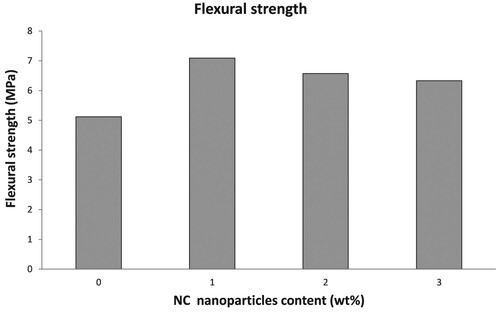
Sun et al. [Citation48] indicated that concrete containing 1 wt% nano-CaCO3 and 20% fly ash exhibited better mechanical properties than the other composites as it exhibited an increase of 24% in the flexural strength and of 34% in the compressive strength compared to the control concrete.
However, the decline in the flexural strength for high content, such as 3 wt% NC, was attributed to the inappropriate dispersion and agglomeration of nanoparticles in nanocomposites [Citation49]. Liu et al. [Citation50] pointed out that the flexural and compressive strengths of cement paste containing nano-CaCO3 reduced when the ratio of nano-CaCO3 exceeded the optimum ratio.
3.2.2. Fracture toughness
The values of fracture toughness for NC nanoparticle composites and plain cement composite are shown in Figure . The results for nanocomposites involving 1, 2, and 3 wt% NC and plain composites, are 0.49, 0.46, 0.43, and 0.35 MPa.m1/2, consecutively. Note that nanocomposites of 1, 2, and 3 wt% NC contents show higher fracture toughness than plain cement composite. This was also attributed to the filler effect, increasing CSH products by addition nucleation effect, which led to a compact microstructure, hence, increasing the densities of nanocomposites. Consequently, nanoparticles reduce the porosity as they packed micro-cracks and voids [Citation51]. Moreover, in similarity research, Nazerigivi et al. [Citation52] searched the influence of SiO2 nanoparticle dispersion on the fracture toughness of concrete. The study reported that nanoparticles act as ultra-fine aggregate, becoming an obstacle to the micro-crack propagation. Thus, nanocomposites can withstand a higher load without expanding the micro-crack propagation compared to the control concrete. In our study, the improvement in fracture toughness could be due to the resisting of NC nanoparticles for unstable crack propagation in cement nanocomposites. As shown in Figure , the optimal content is 1 wt% NC as the nanocomposites with 1 wt% NC reaches the highest value of the fracture toughness than the other values presented in the Figure . Moreover, it increases by 41% compared to plain composites. Therefore, the optimum nanoparticle content could be found to extend the lifetime of the cement nanocomposites without encouraging further micro-crack development in the nanomaterial.
3.3. SEM images of specimens
Figure (a-d) shows the SEM micrographs of NC nanoparticle-cement composites and plain cement composite. The comparison between SEM images of the samples in this study depended primarily on two factors: (1) CSH products and (2) pores or voids, and observed micro-crack. As shown in Figure (a), more pores and micro-crack are present in plain cement composite compared to those in nanocomposites. Figure (b) shows the microstructure of the nanocomposite with 1 wt% NC. It was clearly observed that the microstructure was dense with few pores or voids due to the filler effects. Moreover, for this microstructure, more CSH products are present. On the other hand, as nanoparticle content increases behind the optimum content, the poor distribution and agglomeration of the nanoparticles could increase porosity and weaken the microstructure [Citation46]. For example, in Figure (d), the nanocomposite with 3 wt% NC shows further pores or voids than 1 wt% NC nanocomposite, which indicates a relatively weak structure.
4. Conclusions
This study analyzed the effect of different contents (1, 2, and 3 wt%) of NC nanoparticles on the microstructure and flexural strength and fracture toughness of cement nanocomposites. The results of the XRD showed that the microstructure of cement nanocomposites was compact with high CSH products owing to the additional nucleation effect of NC nanoparticles. The flexural strength and fracture toughness of nanocomposites showed higher values compared to plain composites. The best content of NC nanoparticles was found to be 1 wt% because this content increased the values of flexural strength by 39% and fracture toughness by 41%, compared with the control composite. This improvement was attributed to the filler effect and the production of more CSH products by the additional nucleation effect that enhances the microstructures of cement nanocomposites. Moreover, nano-CaCO3 could resist unstable micro-crack propagation in cement nanocomposites by filling micro-cracks and voids. SEM images confirmed the densification of the microstructures for cement nanocomposites in terms of the lower porosity and existence of extra CSH products. Indeed, considerable studies are required to solve the agglomeration problems of NC nanoparticles when high contents are used.
Disclosure statement
No potential conflict of interest was reported by the author(s).
References
- Contreras J, Rodríguez E. Nanostructured insulators – a review of nanotechnology concepts for outdoor ceramic insulators. Ceram Int. 2017;43:8545–8550. doi: 10.1016/j.ceramint.2017.04.105
- Sharma G, Kumar A, Sharma S, et al. Novel development of nanoparticles to bimetallic nanoparticles and their composites: a review. J King Saud Univ Sci. 2019;31:257–269. doi: 10.1016/j.jksus.2017.06.012
- Kholiya K, Pandey K. High pressure compression behaviour of bulk and nanocrystalline SnO2. J Taibah Univ Sci. 2019;13:592–596. doi: 10.1080/16583655.2019.1611369
- Mathew J, Joy J, George C. Potential applications of nanotechnology in transportation: a review. J King Saud Univ Sci. 2019;31:586–594. doi: 10.1016/j.jksus.2018.03.015
- Vadivel S, Maruthamani D, Kumaravel M, et al. Supercapacitors studies on BiPO4 nanoparticles synthesized via a simple microwave approach. J Taibah Univ Sci. 2017;11:661–666. doi: 10.1016/j.jtusci.2016.09.007
- Joseph A, Joshi G. High performance of fluoro polymer modified by hexa-titanium boride nanocomposites. J Mater Sci: Mater Elec. 2018;29:4749–4769.
- Rasool G, Zhang T, Shafiq A, et al. Influence of chemical reaction on marangoni convective flow of nanoliquid in the presence of lorentz forces and thermal radiation: a numerical investigation. J Adv Nanotech. 2018;1:32–49. doi: 10.14302/issn.2689-2855.jan-19-2598
- Naseem A, Shafiq A, Zhao L, et al. Analytical investigation of third grade nanofluidic flow over a Riga plate using Cattaneo-Christov model. Results Phys. 2018;9:961–969. doi: 10.1016/j.rinp.2018.01.013
- Shafiq A, Rasool G, Khalique CM, et al. Second grade bioconvective nanofluid flow with buoyancy effect and chemical reaction. Symmetry. 2020;12:621. doi: 10.3390/sym12040621
- Rasool G, Zhang T, Shafiq A. Second grade nanofluidic flow past a convectively heated vertical Riga plate. Phys Scr. 2019;94:e125212. doi: 10.1088/1402-4896/ab3990
- Shafiq A, Zari I, Rasool G, et al. On the MHD casson axisymmetric marangoni forced convective flow of nanofluids. Math. 2019;7:1087. doi: 10.3390/math7111087
- Shafiq A, Hammouch Z, Sindhu TN. Bioconvective MHD flow of tangent hyperbolic nanofluid with newtonian heating. Int J Mech Sci. 2017;133:759–766. doi: 10.1016/j.ijmecsci.2017.07.048
- Shafiq A, Khan I, Rasool G, et al. Influence of single- and multi-wall carbon nanotubes on magnetohydrodynamic stagnation point nanofluid flow over variable thicker surface with concave and convex effects. Math. 2020;8:104. doi: 10.3390/math8010104
- Shafiq A, Zari I, Khan I, et al. Marangoni driven boundary layer flow of carbon nanotubes toward a riga plate. Front Phys. 2020;7:e215. doi: 10.3389/fphy.2019.00215
- Rasool G, Shafiq A, Khan I, et al. Entropy generation and consequences of MHD in darcy–forchheimer nanofluid flow bounded by non-linearly stretching surface. Symmetry (Basel). 2020;12:e652. doi: 10.3390/sym12040652
- Shafiq A, Rasool G, Khalique CM. Significance of thermal Slip and convective boundary conditions in three dimensional rotating darcy-forchheimer nanofluid flow. Symmetry (Basel). 2020;12:e741. doi: 10.3390/sym12050741
- Rasool G, Zhang T, Chamkha A, et al. Entropy generation and consequences of binary chemical reaction on MHD darcy–forchheimer Williamson nanofluid flow over non-linearly stretching surface. Entropy. 2020;22:e18. doi: 10.3390/e22010018
- Carbone M, Donia D, Sabbatella G, et al. Silver nanoparticles in polymeric matrices for fresh food packaging. J King Saud Univ Sci. 2016;28:273–279. doi: 10.1016/j.jksus.2016.05.004
- Vakilifard M, Mahmoodi M. Dynamic moduli and creep damping analysis of short carbon fiber reinforced polymer hybrid nanocomposite containing silica nanoparticle-on the nanoparticle size and volume fraction dependent aggregation. Compos Part B: Eng. 2019;167:277–301. doi: 10.1016/j.compositesb.2018.12.045
- Singh S, Kumar A, Jain A. Improving tensile and flexural properties of SiO2-epoxy polymer nanocomposite. Mater Today. 2018;5:6339–6344.
- Ghafari E, Ghahari S, Feng Y, et al. Effect of Zinc oxide and Al-Zinc oxide nanoparticles on the rheological properties of cement paste. Compos Part B: Eng. 2016;105:160–166. doi: 10.1016/j.compositesb.2016.08.040
- Bałata A, Mazu J. Effect of carbon nanoparticle reinforcement on mechanical and thermal properties of silicon carbide ceramics. Ceram Int. 2018;44:10273–10280. doi: 10.1016/j.ceramint.2018.03.034
- Mohammadi H, Nilforoushan M, Tayebi M. Effect of nanosilica addition on bioactivity and in vivo properties of calcium aluminate cement. Ceram Int. 2020;46:4335–4343. doi: 10.1016/j.ceramint.2019.10.156
- Meddah MS, Praveenkumar TR, Vijayalakshmi MM, et al. Mechanical and microstructural characterization of rice husk ash and Al2O3 nanoparticles modified cement concrete. Constr Build Mater. 2020;255:e119358. doi: 10.1016/j.conbuildmat.2020.119358
- Smith A, Chotard T, Bonnet J, et al. Ultrasonic characterization of model mixtures of hydrated aluminous. Cem J Mater Sci. 2002;37:3847–3385. doi: 10.1023/A:1019634901368
- Hazem M, Hashem F, El-Gamal S, et al. Mechanical and microstructure characteristics development of hardened oil well cement pastes incorporating fly ash and silica fume at elevated temperatures. J Taibah Univ Sci. 2020;14:155–167. doi: 10.1080/16583655.2020.1711998
- Papadakis V. Experimental investigation and theoretical modeling of silica fume activity in concrete. Cem Concr Res. 1999;29:79–86. doi: 10.1016/S0008-8846(98)00171-9
- Wang Y, Ying G, Hu J, et al. Analysis for influence factors of cold recycling mixture compaction test. Appl Mech Mater. 2012;204–208:1633–1637. doi: 10.4028/www.scientific.net/AMM.204-208.1633
- Colovic B, Jokanovic V, Jovic N. Creating of highly active calcium-silicate phases for application in endodontics. Sci Sinter. 2013;45:341–350. doi: 10.2298/SOS1303341C
- Jokanovic V, Colovic B, Mitric M. Synthesis and properties of a new dental material based on nano-structured highly active calcium silicates and calcium carbonates. Int J Appl Ceram Technol. 2014;11:57–64. doi: 10.1111/ijac.12070
- Dizaj S, Jalali M, Zarrintan M, et al. Calcium carbonate nanoparticles; potential in bone and tooth disorders. Pharm Sci. 2015;20:175–182.
- Bicchieri M, Valentini F, Calcaterra A, et al. Newly developed nano-calcium carbonate and nano-calcium propanoate for the deacidification of library and archival materials. J Anal Methods Chem. 2017;2017:e2372789. doi: 10.1155/2017/2372789
- Miranda TB, Silva GG. Hierarchical microstructure of nanoparticles of calcium carbonate/epoxy composites: thermomechanical and surface properties. Express Polym Lett. 2020;14:179–191. doi: 10.3144/expresspolymlett.2020.15
- Cosentino I, Liendo F, Arduino M, et al. Nano CaCO3 particles in cement mortars towards developing a circular economy in the cement industry. Procedia Struct Integrity. 2020;26:155–165. doi: 10.1016/j.prostr.2020.06.019
- Mydin R, Zahidi I, Ishak N, et al. Potential of calcium carbonate nanoparticles for therapeutic applications. Mal J Med Health Sci. 2018;14:201–206.
- Parhizkar M, Nezhad K, Rezaei A. Mechanical and thermal properties of Homo-PP/GF/CaCO3 hybrid nanocomposites. Adv Mater Res. 2016;5:121–130. doi: 10.12989/amr.2016.5.2.121
- Yang G, Heo Y, Park S. Effect of morphology of calcium carbonate on toughness behavior and thermal stability of epoxy-based composites. Proc. 2019;7:178.
- Ge Z, Wang K, Sun R, et al. Properties of self-consolidating concrete containing nano-CaCO3. J Sustain Cem Based Mater. 2014;3:191–200. doi: 10.1080/21650373.2014.903213
- Wu Z, Shi C, Khayat K. Multi-scale investigation of microstructure, fiber pullout behavior, and mechanical properties of ultra-high performance concrete with nano-CaCO3 particles. Cem Concr Compos. 2018;86:255–265. doi: 10.1016/j.cemconcomp.2017.11.014
- Patel D, Varia D, Mehta K. Review on comparative study by using nano CaCO3 and nano Fe2O3 in fly ash containing concrete. Int J Res Appl Sci Eng Technol (IJRASET). 2018;6:11–14. doi: 10.22214/ijraset.2018.6003
- Zhao H, Sun G, Yu L, et al. Hydration of early age cement paste with nano-CaCO3 and SAP by LF-NMR spectroscopy: mechanism and prediction. Model Simul Eng. 2019;1:10–20.
- Supit S, Shaikh F. Effect of nano-CaCO3 on compressive strength development of high volume fly ash mortars and concretes. J Adv Concr Technol. 2014;12:178–186. doi: 10.3151/jact.12.178
- Cao M, Ming X, He K, et al. Effect of macro-, micro- and nano-calcium carbonate on properties of cementitious composites—a review. Materials (Basel). 2019;12:781–801. doi: 10.3390/ma12050781
- Yang H, Che Y. Research of mortar containing phosphorous slag and calcium carbonate nanoparticles. Adv Mater Sci Eng. 2019;1:8–18.
- Peng Y, Ma K, Long G, et al. Influence of nano-SiO2, nano-CaCO3 and nano-Al2O3 on rheological properties of cement–fly ash paste. Materials (Basel). 2019;12:2598–2620. doi: 10.3390/ma12162598
- Li W, Huang Z, Zu T, et al. Influence of nanolimestone on the hydration, mechanical strength, and autogenous shrinkage of ultrahigh-performance concrete. J. Mater. Civ. Eng. 2016;28:e04015068.
- Liu X, Wang X, Liu A, et al. Study on the mechanical properties of cement modified by nanoparticles. Appl Mech Mater. 2012;157-158:161–164. doi: 10.4028/www.scientific.net/AMM.157-158.161
- Sun Y, Zhang P, Guo W, et al. Effect of nano-CaCO3 on the mechanical properties and durability of concrete incorporating fly Ash. Adv Mater Sci Eng. 2020;2020:e7365862.
- Shaikh F, Supit S. Mechanical and durability properties of high volume fly ash (HVFA) concrete containing calcium carbonate (CaCO3) nanoparticles. Constr Build Mater. 2014;70:309–321. doi: 10.1016/j.conbuildmat.2014.07.099
- Liu X, Chen L, Liu A, et al. Effect of nano-CaCO3 on properties of cement paste. Energy Procedia. 2012;16:991–996. doi: 10.1016/j.egypro.2012.01.158
- Al-Wakeel S, Nemecek J, Li L, et al. The effect of ittroducting nanoparticles on the fracture toughness of well cement paste. Int J Greenh Gas Con. 2019;84:147–153. doi: 10.1016/j.ijggc.2019.03.009
- Nazerigivi A, Nejati H, Ghazvinian A, et al. Effects of SiO2 nanoparticles dispersion on concrete fracture toughness. Constr Build Mater. 2018;171:672–679. doi: 10.1016/j.conbuildmat.2018.03.224


